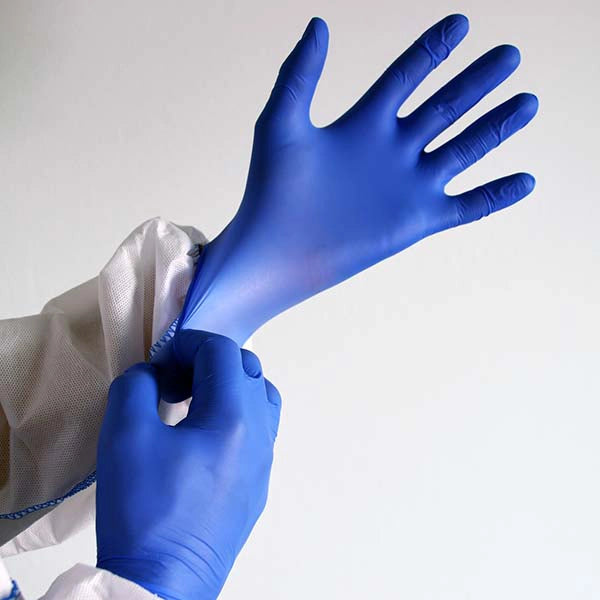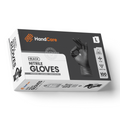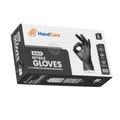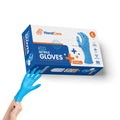Disposable gloves are a must-have personal protective equipment for pest control. They protect the hands from harsh chemicals and pesticides that cause skin irritation and allergies. Besides, minimizing exposure to pesticides can help reduce the risk of developing certain chronic conditions such as Parkison’s.
There are many different types of disposable gloves available in the market, but not all are suitable for pest control. The best protective gloves for pest control need to be durable, chemical resistant, yet comfortable to wear.
How to Choose the Best Gloves for Pesticides:
Selecting the right gloves for handling pesticides is critical to ensure your safety and prevent exposure to harmful chemicals. Pesticides can be hazardous, and improper protection can lead to serious health issues. Here are the key factors to consider when choosing the best gloves for pesticide use:
Material
The material of the gloves is the most important factor to consider. Nitrile gloves are highly recommended for pesticide handling due to their excellent chemical resistance, durability, and flexibility. They provide a strong barrier against many types of pesticides.
Latex gloves can also be used but are less resistant to certain chemicals and may cause allergic reactions in some individuals. Avoid using vinyl gloves, as they do not offer sufficient protection against most pesticides.
Thickness
Thicker gloves generally offer better protection against chemicals. When handling pesticides, choose gloves that are at least 14 mils thick. This thickness provides a robust barrier while still allowing for adequate dexterity.
👉 Read our full guide about Nitrile Gloves Thickness Chart
Thicker gloves will have a lower permeation rate, meaning chemicals will take longer to penetrate the material.
Comfort and Fit
Comfort and fit are essential for prolonged use. Gloves should fit snugly without being too tight, allowing for flexibility and movement. Poorly fitting gloves can cause hand fatigue and reduce the ability to perform tasks effectively. Many gloves come in various sizes, so choose the size that best fits your hand.
Chemical Resistance Ratings
Check the chemical resistance ratings provided by the glove manufacturer. These ratings indicate how well the gloves protect against specific chemicals and for how long. Always choose gloves that are rated for the particular pesticides you will be handling. Manufacturers often provide charts or guides to help you select the appropriate gloves based on the chemicals you will encounter.
7 Options for Pesticide Gloves
Here’s a list of seven chemical resistant gloves for pest control that you can use to keep yourself safe while handling toxic chemicals:
1. Ansell Touch n Tuff 92-675 Disposable Nitrile Gloves
The Ansell Touch n Tuff Nitrile Disposable glove is one of the best chemical resistant gloves on the market today. These premium quality gloves are made from nitrile, providing incredible resistance to punctures, cuts, and chemical abrasion.
The extended 9.4-inch cuff length provides an adequate shield for your wrists and forearms from any potential spills. Besides, they are ambidextrous and can fit any hand.
They come with textured fingertips that provide a secure grip while working in wet conditions. You can pick the perfect fit for your fingers from an assorted range of sizes including, x-small, small, medium, large, x-large, xx-large, and xxx-large.
Key Features:
- Latex-free and powder-free
- 9.4-inch length and 5-mil thickness
- Chemical resistant
- 100 pieces per box
- Textured fingertips
2. CSP Black Nitrile Gloves
The CSP black nitrile gloves are a perfect option for users that prefer dark-colored gloves. The black color can conceal dirt, stains, and grime as you work.
These chemical resistant gloves are ambidextrous, providing enough flexibility to carry out your work. Besides, the micro-textured fingers increase the grip while handling pesticides. You can maneuver around with the chemicals firmly in your hand.
CSP nitriles are also extra-thick at 5.5 mil, providing adequate protection for your skin. The nitrile material means that you have impervious and chemical resistant gloves.
Key Features:
- Latex-free
- Ambidextrous design
- Micro-textured fingers
- Black in color
- Come in boxes of 100 pieces each
- 5.5-mil thick
3. Liberna Rolled Cuff Nitrile Gloves
The Liberna Rolled Cuff Nitrile gloves offer unmatched comfort and dexterity. The glove’s ergonomic design and rolled cuff maximize comfort for the user. The rolled cuff makes it easier to wear and remove.
The nitrile material forms an impenetrable barrier, protecting you from chemical burns and reactions. Nitrile provides up to three times the puncture resistance of latex, making them more durable. Besides, you do not have to worry about allergic reactions to the latex protein.
The Liberna Rolled Cuff disposable gloves measure 9 inches from the fingertips to the cuff, providing maximum protection for your wrist and mid-arms.
Key Features:
- Made from Nitrile
- Durable
- Puncture and chemical resistant
- Rolled cuffs design
- Latex and powder-free
- Enhanced tactile sensitivity
4. GLOVEWORKS HD Industrial Nitrile Disposable Gloves
Gloveworks’ Industrial nitrile disposable gloves offer a perfect combination of strength, flexibility, and chemical resistance. They are powder-free and latex-free, making them excellent for users with sensitive skin.
These industrial work gloves measure 9.5 inches from fingertips to the cuff, providing reliable protection to your forearm. The micro-roughened surface provides a superior grip while working with wet surfaces.
The 8.0 mil thickness provides medium-duty protection against tears, punctures, and chemical abrasion. Additionally, they have a chlorinated finish, making them easier to change your gloves.
📍 Shop 8 Mil Nitrile Gloves with 50% off now
Key Features:
- 9.5-inch long, 8.0 mil thick
- Chlorinated finish
- Micro-roughened texture
- Latex-free, powder-free
- Available in small, medium, large, x-large, and xx-large
5. SAS Safety 66573 Astro Grip Nitrile Disposable Glove
SAS Safety’s Astro-grip is abrasion- and chemical-resistant, making them ideal for pesticide application. At 6 mil thickness, the gloves are impermeable, protecting your hands from chemical burns.
The glove set is ambidextrous, allowing them to fit snugly on the hand. Additionally, the dual-sided textured surface can help improve your grip while working. The synthetic nitrile material provides superior puncture, mechanical and chemical resistance.
The dual-sided textured grip may result in these working gloves feeling smaller. You can consider purchasing a size higher for a more snug fit.
Key Features:
- Abrasion and chemical resistant
- Dual-sided textured grip
- Nitrile material
- Powder and latex-free
- 100 pieces per box
6. Dura-Gold HD Black Nitrile Disposable Gloves
These Dura-Gold heavy-duty nitrile gloves are perfect for highly toxic chemical or pesticide applications. The 6-mil thickness provides an effective barrier to protect your arms from any chemical burns.
The thick, nitrile material can resist tears, cuts, punctures, and snags, offering maximum protection. The exterior surface features an enhanced texture grip on wet, dry, or oily surfaces.
Despite the thickness, the ergonomic design of these working gloves makes them easier to don and remove. The latex-free glove is ideal for users allergic to latex protein.
Key Features:
- Ergonomic, ambidextrous design
- Thick, nitrile material, 6-mil
- Enhanced texture grip
- Latex and powder-free
7. YOTU Disposable Nitrile Gloves
The YOTU disposable gloves come in a rolled cuff design that makes it easier and quicker to open, wear and remove the glove. The gloves have a six-millimeter thickness that provides adequate protection from chemicals and mechanical abrasion.
The non-allergenic gloves do not have any latex or powder, making them comfortable to wear. They are also ambidextrous and provide a perfect fit for your palms and fingers.
These gloves come in various sizes, including medium, large, and extra-large for versatility. The long, stretchy gloves are 10 inches in length, providing enough protection for your forearms.
Key Features:
- 10 inches long, 6-mil thick
- Ambidextrous
- Rolled cuff
- Latex-free
- Available in 100 gloves per box
Where to Buy The Best Disposable Gloves for Pest Control
Pesticide application may involve the use of abrasive and toxic chemicals that can cause skin irritations, allergies, and burns. You can protect your skin by investing in the best gloves for pest control.

The list above can provide you with a clue of products to look for during your search.
Remember, the best disposable gloves are comfortable to wear, offer protection from chemicals, and are resistant to punctures or tears.
You can check our collections on gloves.com and save up to 50% on your order.
Gloves For Pest Control: Frequently Asked Questions
What PPE is used for pesticide?
Personal protective equipment (PPE) used for handling pesticides includes gloves, protective clothing (such as coveralls or long-sleeved shirts and long pants), goggles or face shields, respirators, and chemical-resistant boots. These items help protect the skin, eyes, respiratory system, and overall body from exposure to harmful chemicals.
Do latex gloves protect against pesticides?
Latex gloves offer some protection against pesticides but are generally not recommended for this purpose. They can degrade when exposed to certain chemicals found in pesticides and may not provide adequate protection. Nitrile gloves are a better choice for handling pesticides due to their superior chemical resistance and durability.







